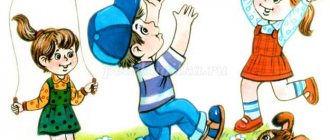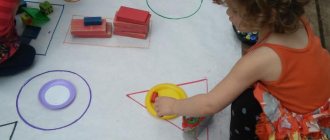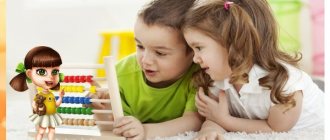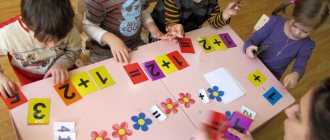Why is this so important?
- Mathematics is one of the most significant subjects. However, it is precisely this that often causes considerable difficulties for students.
- Studying this subject has a beneficial effect on the child’s cognitive abilities (thinking, memory, speech)
- Mathematical skills improve the emotional-volitional sphere, form perseverance and determination
- Improves the basics of a child's imagination
The role of mathematics in life
What skills should a child develop by the end of the preschool period?
By the end of the preschool period, the child should have the following mathematical skills:
- Ability to compare values based on basic characteristics; the formation of ideas about the concepts of “more-less”, “higher-lower”, etc.
- The ability to group objects according to their basic properties (basics - size, color, purpose, material, shape)
- Ability to compare parts and wholes; ability to assemble a picture from at least 12-24 fragments
- Developed counting skills and the ability to perform mathematical operations with numbers within ten
- Children’s development of quantitative and qualitative representations of the subject
The essence of mathematical development
Numbers, quantity, counting
Children get acquainted with the numbers 0...20, learn to write printed numbers in notebooks. They learn to count within 20, using ordinal numbers (second, fifth). Learn to compare adjacent numbers. Get acquainted with such concepts as less, more, the same amount. Convert equalities into inequalities and vice versa. Get acquainted with the mathematical signs + - = < >. They learn to compare numbers, figures, and the number of objects up to 20. They learn to count by 2s and 3s within 21. They study the composition of the number of the first ten. They come up with problems based on drawings and solve them based on clarity.
Features of the formation of mathematical concepts depending on age
Considering that preschool age is conventionally divided into three main periods, goals, objectives, as well as methods and forms of mathematical education of children will also differ.
Junior preschool period. At this time, the necessary mathematical skills and concepts are just beginning to develop. Therefore, the child needs to be given an idea of basic operations. The best games for developing thinking skills are children's mosaics (from 5 fragments), addition of geometric shapes (from 4 parts). The method of developing quantitative and qualitative concepts in preschoolers requires special attention.
Middle preschool period. There is an active development of the sign-symbolic function of consciousness. The child can already be taught to count and the simplest mathematical operations. The foundations of logical thinking are laid. The most preferred games include: “Nonsense”, “Count the objects”, “Find a pair”, “Mathematical lotto”, “Domino figures”. To develop a child’s analytical and synthetic abilities, you can offer him games like tangram, where he will need to make a geometric figure, a silhouette of an animal, etc. from individual parts.
Individual lesson to determine the level of mathematical development
In older preschool age, the child’s independence and his ability to self-organize begin to play an increasingly noticeable and significant role. Logical thinking is becoming increasingly important.
The child begins to try to compose stories from pictures, compose logical series, observing the correct sequence of elements.
Math tests for kids 3-4 years old
Structure of a math lesson for a preschooler
The correct structure of the lesson is another important condition on which the methodology for the mathematical development of preschool children is based.
Games used in mathematics classes
- Introductory part. Logical warm-up. Includes the simplest tasks for children, which should “warm up” the child’s mind, interest him and prepare him for the lesson.
- The main part of the lesson, during which new material is studied to form mathematical concepts, or reinforcement of what has already been learned. Exercises can be selected using special methodological literature (a good example is the book compiled by E.I. Shcherbakova “Theory and Methods of Mathematical Development for Preschool Children”).
- 3Finger gymnastics. Redirects the child's attention and serves as a warning against fatigue. For the same purposes, you can use physical exercise (if the lesson was associated primarily with intellectual activity), articulatory gymnastics or eye exercises (if the child had an active lesson using outdoor games).
- Repetition of covered material.
- Drawing, lacing, or games aimed at developing fine motor skills.
Studying shape and size in physical education classes
Developed mathematical skills in preschool children will allow him not only to successfully start school, but also to develop such qualities as perseverance, attention, and determination.
leave a comment
What methods are best used to develop a preschooler's mathematical understanding?
The visual method plays the most important role in teaching children mathematics, especially when it comes to the early preschool period.
Methods for developing mathematical knowledge
There are the following types of visual teaching methods:
- Working with handouts or demonstration materials. Using a plotless or plot method (you can take as a basis the plot of any fairy tale familiar to a child, where counting or numbers would appear)
- Volumetric or planar. Classes using special counting materials (for example, children's abacus, sticks, cubes, etc.)
- Homemade or factory made.
Handouts for mathematical classes
In order to use visual material more effectively, it is necessary to build developmental classes taking into account the following patterns:
- The study of each new topic should begin with more voluminous visual material. This will make it easier for the child to understand
- As the child grows up, it is necessary to ensure that the proportion of volumetric and plot-based visual material decreases, and the proportion of flat and plotless material increases
- It is advisable to use several types of visual material to solve one software problem
- It is very advisable to familiarize the child with new material in advance.
Separately, it is worth considering the requirements for visual aids.
Didactic material for classes
As we have already indicated above, it can be either ready-made at the factory or made by parents. However, it is important that it matches the following:
- Hygiene. Toys must be made from environmentally friendly, safe materials and have all the necessary certificates
- Aesthetics. Attractive material is more likely to attract the child's attention
- A reality that allows a child to perceive the material being studied without distortion
- Durability and reliability
- Variety and sufficient quantity to allow the use of variable techniques
- The principle of logical construction that combines the basics of the material
- Uniformity
Play corner with didactic materials
A significant advantage of the practical teaching method is that it most fully explains to the child why he is studying this or that material. And how exactly will the knowledge gained be useful to him in the future?
- Active application in practice of a variety of didactic material
- Performing a variety of both mental and practical activities
- Development of the skill of predicting the outcome of actions with various types of didactic material
- Not only instilling mathematical skills in the child, but also a detailed explanation of their role in the child’s life (in play activities, in everyday life, etc.)
The verbal method of teaching is based on direct interaction between the child and the parent or teacher.
That is why the main requirements for this method will be aimed at the speech of the participants in the process
The speech of the parent or teacher should be:
- Literate
- Rosary
- Emotional and alive
- Available
- Friendly
- Moderately loud
Speech development in mathematics classes
The pace of speech, its intonation and other features must be adjusted depending on the individual age characteristics of the child. For example, a child of primary preschool age perceives rather slow speech much better; unformed memory processes require repeated repetitions.
Development of logic and spatial thinking in a playful way
When talking with an older child, you can somewhat speed up the pace of speech and also make more active use of problem situations.
Certain requirements are also imposed on children’s speech. She must be:
- Competent
- Contain the necessary mathematical terminology and basic mathematics by age
- Legible and understandable
- The child must speak in complete common sentences with correct grammatical structure
- Have sufficient volume
Orientation in space
1) Preschoolers learn to determine the position of objects in space - right, left, below, above.
2) Determine the direction of movement - from right to left, from top to bottom, back, forward, in the opposite direction, in the same direction;
3) Get acquainted with the concepts - close and far, low and high, closer, further, nearby.
4) Determine their position in space - outside or inside. Among the objects: on, in, under, over, in front of, between, to, from, through.
5) Orient themselves on a piece of paper, in a column and line of cells.





